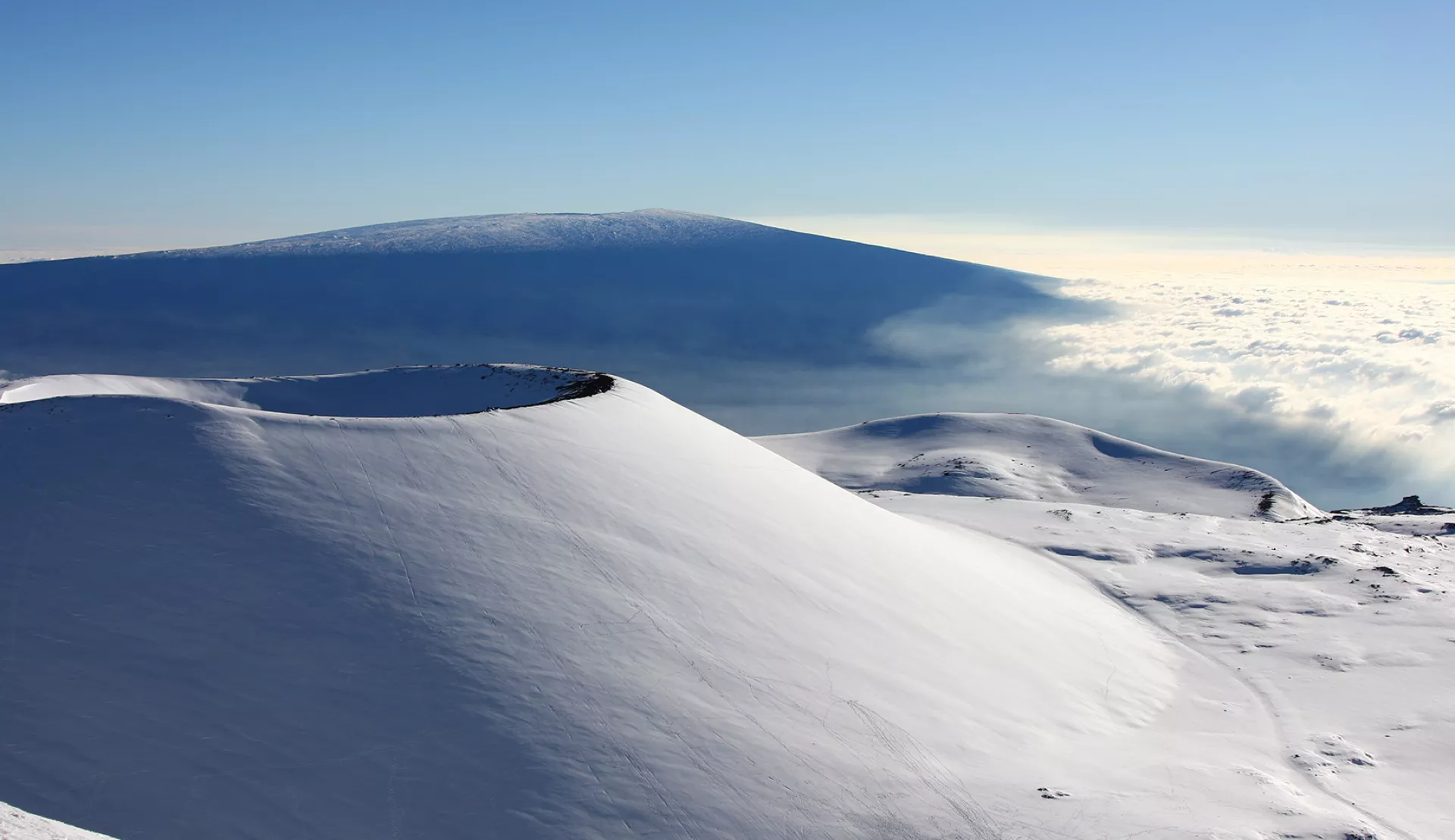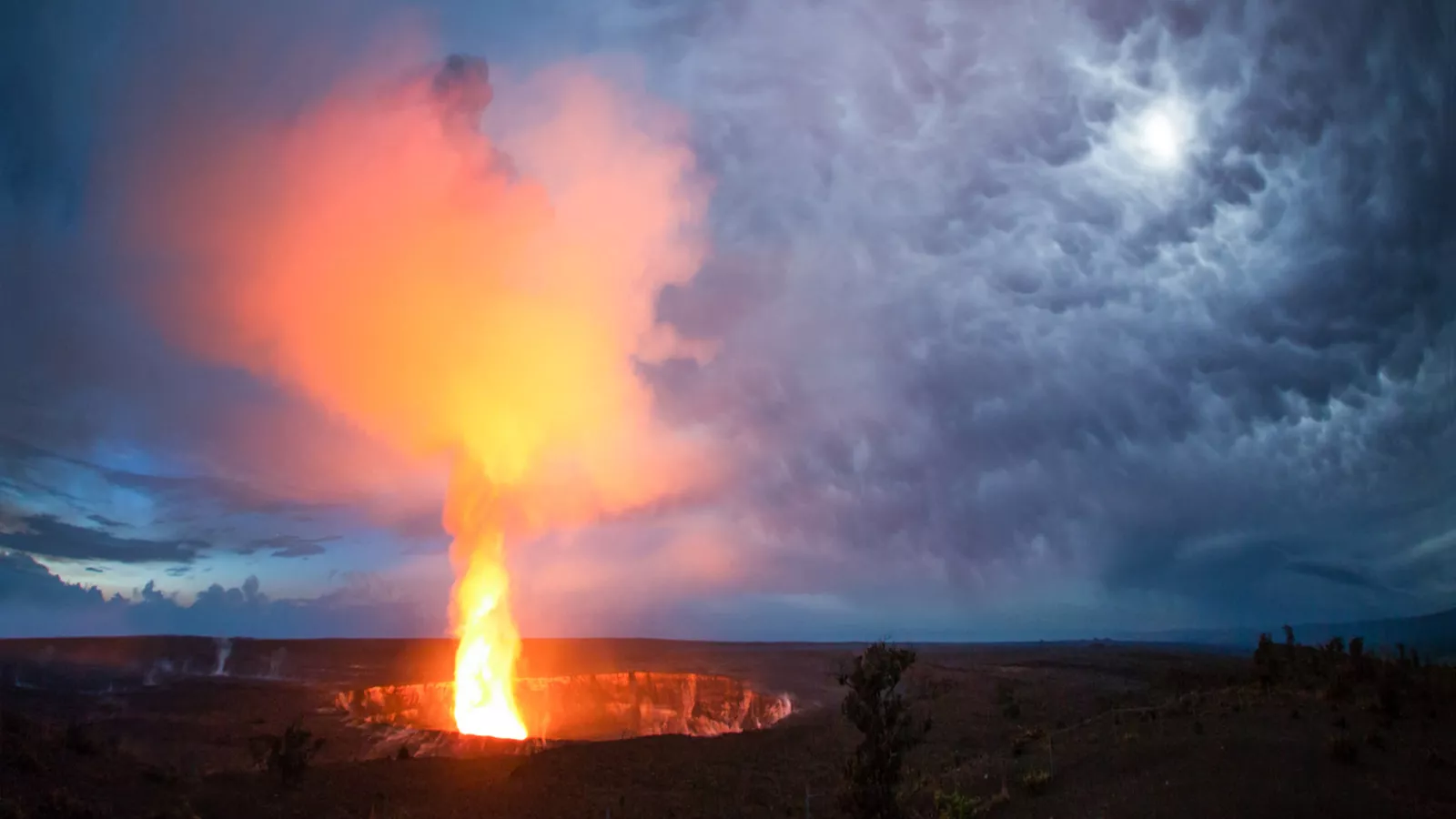
 The Race of the Goddesses
The Race of the Goddesses
The Race of the Goddesses
The island of Hawaiʻi is an island of extremes – the dry deserts of Kaʻū and the lush forests of Kohala, the soaring cliffs of Hāmākua and sandy beaches of black, green and white, and of course, the snow-capped peak of Maunakea and the raging volcanic fires of Kīlauea. Many of these landscapes have legends attached to them, telling of the gods and spirits that shaped the island.
Poliʻahu is the goddess of snow. Her domain is atop Maunakea, embraced in clouds and mist, wearing a mantle of snow, feeding the springs and streams of the fertile landscape below. The Hāmākua coast on the eastern flank of Maunakea is her playground. She is a very competitive athlete, known to take human form to challenge the people of Hāmākua to her favorite sport: hōlua, sliding down the slopes of her mountain on a wooden sled at great speed, launching into the ocean at the end of the course.
Another goddess who happens to be a hōlua enthusiast is Pele, goddess of the volcanic fire. After traveling the craters of the Hawaiian islands looking for a suitable home, Pele settled at Kīlauea. Her domain, the southern half of Hawaiʻi Island, is marked by the fiery birth of new land. Pele is known to appear in various forms to people, including a beautiful maiden – and it is in this form that she challenged Poliʻahu to a hōlua race one day near what is now Laupāhoehoe.
Never one to turn down a challenge, Poliʻahu welcomed the beautiful stranger. They climbed to the top of the hōlua track. The two goddesses were amazingly talented athletes. They rushed down the track toward the sea, Pele ahead, then Poliʻahu, then Pele, then Poliʻahu. As the race grew more and more intense, the ground below the hōlua track began to heat up.
As the ground got hotter and hotter, Poliʻahu realized that it was her rival goddess Pele she was racing. As Poliʻahu inched ahead in the race, Pele’s frustration got the best of her. She dropped her human form and summoned her forces. Great fountains of fire erupted, rushing through long-empty tubes and caverns. Poliʻahu headed back to her summit to safeguard her mantle of snow as Pele’s fire was beginning to singe its edges.
The entire island quaked as the epic battle raged on. As Pele sent stream after stream of molten lava down the side of Maunakea, as quickly as the goddesses had been sliding down the hōlua track, Poliʻahu followed with her snow, chilling and hardening the rivers of fire as they stretched out to the ocean.
Poliʻahu succeeded in pushing Pele’s molten fire back down the caverns of Maunakea into the depths of the island. Maunakea and the northern half of Hawaiʻi Island have since remained free of eruptions, and Pele continues to grow the southern half of the island with her volcanic fires.
The landscapes formed by Pele and Poliʻahu’s battle can be seen along the Hāmākua coast: the soaring cliffs, the jagged shoreline, and jutting peninsula of Laupāhoehoe.
Poliʻahu is the goddess of snow. Her domain is atop Maunakea, embraced in clouds and mist, wearing a mantle of snow, feeding the springs and streams of the fertile landscape below. The Hāmākua coast on the eastern flank of Maunakea is her playground. She is a very competitive athlete, known to take human form to challenge the people of Hāmākua to her favorite sport: hōlua, sliding down the slopes of her mountain on a wooden sled at great speed, launching into the ocean at the end of the course.
Another goddess who happens to be a hōlua enthusiast is Pele, goddess of the volcanic fire. After traveling the craters of the Hawaiian islands looking for a suitable home, Pele settled at Kīlauea. Her domain, the southern half of Hawaiʻi Island, is marked by the fiery birth of new land. Pele is known to appear in various forms to people, including a beautiful maiden – and it is in this form that she challenged Poliʻahu to a hōlua race one day near what is now Laupāhoehoe.
Never one to turn down a challenge, Poliʻahu welcomed the beautiful stranger. They climbed to the top of the hōlua track. The two goddesses were amazingly talented athletes. They rushed down the track toward the sea, Pele ahead, then Poliʻahu, then Pele, then Poliʻahu. As the race grew more and more intense, the ground below the hōlua track began to heat up.
As the ground got hotter and hotter, Poliʻahu realized that it was her rival goddess Pele she was racing. As Poliʻahu inched ahead in the race, Pele’s frustration got the best of her. She dropped her human form and summoned her forces. Great fountains of fire erupted, rushing through long-empty tubes and caverns. Poliʻahu headed back to her summit to safeguard her mantle of snow as Pele’s fire was beginning to singe its edges.
The entire island quaked as the epic battle raged on. As Pele sent stream after stream of molten lava down the side of Maunakea, as quickly as the goddesses had been sliding down the hōlua track, Poliʻahu followed with her snow, chilling and hardening the rivers of fire as they stretched out to the ocean.
Poliʻahu succeeded in pushing Pele’s molten fire back down the caverns of Maunakea into the depths of the island. Maunakea and the northern half of Hawaiʻi Island have since remained free of eruptions, and Pele continues to grow the southern half of the island with her volcanic fires.
The landscapes formed by Pele and Poliʻahu’s battle can be seen along the Hāmākua coast: the soaring cliffs, the jagged shoreline, and jutting peninsula of Laupāhoehoe.

